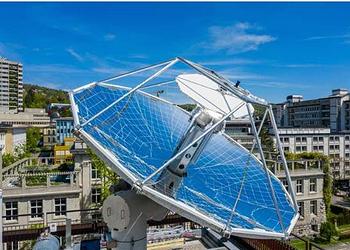http://ens-newswire.com/2019/06/25/carbon-neutral-fuel-created-from-sunlight-and-air/
Carbon-neutral Fuel Created from Sunlight and Air
Posted by News Editor in Latest News, RSS, Sci/Tech on June 25, 2019 6:17 am / no comments
ZURICH, Switzerland, June 25, 2019 (ENS) – An innovative technology that produces liquid hydrocarbon fuels from only sunlight and air has been developed by researchers from the Swiss Federal Institute of Technology Zurich, known as ETH Zurich.
For the first time anywhere in the world, scientists have demonstrated the entire thermochemical process chain under real field conditions in a new solar mini-refinery located on the roof of ETH’s Machine Laboratory building in Zurich.

A research plant is located on the roof of the ETH building on Sonneggstrasse in Zurich, Switzerland. (Photo by Alessandro Della Bella / ETH Zurich)
ETH researchers have built a solar plant to produce synthetic liquid fuels that release as much carbon dioxide (CO2) during their combustion as previously extracted from the air for their production.
CO2 and water are extracted directly from ambient air and split using solar energy. This process yields syngas, a mixture of hydrogen and carbon monoxide, which can be processed into kerosene, methanol or other hydrocarbons. These drop-in fuels are ready for use in the existing global transport infrastructure.
Aldo Steinfeld, professor of renewable energy carriers at ETH Zurich, and his research group developed the technology.
“This plant proves that carbon-neutral hydrocarbon fuels can be made from sunlight and air under real field conditions,” Steinfeld explained. “The thermochemical process utilizes the entire solar spectrum and proceeds at high temperatures, enabling fast reactions and high efficiency.”
The solar mini-refinery on the roof of ETH Zurich proves that the technology is feasible, even under the climate conditions prevalent in Zurich. It produces around one decilitre of fuel per day.
Steinfeld and his group are already working on a large-scale test of their solar reactor in a solar tower near Madrid, which is carried out within the scope of the EU project sun-to-liquid. The solar power plant was presented to the public in Madrid at the same time on June 13 as the mini-refinery in Zurich.
The process chain of the new system combines three thermochemical conversion processes:
First, the extraction of CO2 and water from the air. Second, the solar-thermochemical splitting of CO2 and water.
Third, their subsequent liquefaction into hydrocarbons.
First, the extraction of CO2 and water from the air. Second, the solar-thermochemical splitting of CO2 and water.
Third, their subsequent liquefaction into hydrocarbons.
CO2 and water are extracted directly from ambient air via an adsorption/desorption process. Both are then fed into the solar reactor at the focus of a parabolic reflector.
Solar radiation is concentrated by a factor of 3,000, generating process heat at a temperature of 1,500 degrees Celsius inside the solar reactor.
At the heart of the solar reactor is a ceramic structure made of cerium oxide, which enables a two-step reaction, the redox cycle, to split water and CO2 into syngas. This mixture of hydrogen and carbon monoxide can then be processed into liquid hydrocarbon fuels through conventional methanol or Fischer–Tropsch synthesis.
Carbon-neutral fuels are the key to making aviation and maritime transport sustainable.
Two spin-offs have already emerged from Steinfeld’s research group: Synhelion, founded in 2016, commercializes the solar fuel production technology. Climeworks, founded in 2010, commercializes the technology for CO2 capture from air.
The next project goal is to scale the technology for industrial implementation and make it economically competitive. “A solar plant spanning an area of one square kilometre could produce 20,000 litres of kerosene a day,” said Philipp Furler, director and chief technical officer of Synhelion and a former doctoral student in Steinfeld’s group.
“Theoretically, a plant the size of Switzerland, or a third of California’s Mojave Desert, could cover the kerosene needs of the entire aviation industry,” Furler said. “Our goal for the future is to efficiently produce sustainable fuels with our technology and thereby mitigate global CO2 emissions.”
沒有留言:
張貼留言